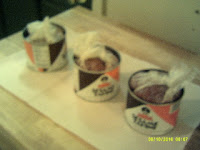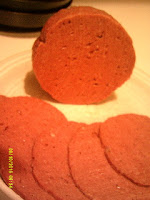Bologna
Oct 02, 2016
Skip to Recipe
As a child I was never a great fan of bologna, but I could eat it without gagging. It wasn't that I disliked the flavor, or even that we had it so terribly often that I grew tired of it — in fact, although we had bologna more often than other cold cuts, we rarely ate cold cuts at all. It just never inspired any great desire in me, and this response continued pretty much into full adulthood. This all changed while I was visiting my sister this past summer.
Now I was raised in the Southern United States, and in "the South" we don't have much of a tradition regarding the "neighborhood delicatessen". They just didn't exist in most places where I lived, while I was growing up. My sister, however, moved 'way up North as a very young bride, and only visits the Old South on certain special occasions. In the Northern states, they do have — and have pretty much always had - traditions concerning the neighborhood delicatessens. Sis has been there long enough now to become steeped in many Northern traditions (some here call it "becoming Yankeefied", but we love her anyway!), including patronizing the neighborhood deli.
So, while we were visiting this summer, my brother-in-law, decided that I needed to try out his favorite "ring bologna", made on-site at a particular deli/butcher shop. Now most Southerners don't have much exposure to ring bologna. They might have heard of it in passing, but probably have never seen it (other than maybe in pictures), and my first look at it didn't register much except "looks like a kielbasa that someone forgot to smoke." I tried it out though, along with a little horseradish sauce (also recommended by Dan) and was pleasantly surprised at the taste. The meat mix was noticeably more granular than your typical grocery-store bologna, and you could actually taste the meat in it! Good tip, Dan!
Anyway, as you can tell, I liked it, but about the only way you would ever be able to find it anywhere in the South is to travel long distances away from home, or purchase it mail-order (or online). Neither of those options appeal to me, so — since I'm now "experienced" at making other home-made cold cuts — I decided to try to make my own bologna.
Surprisingly, the Internet provides a plethora of recipes for home-made bologna, and even more surprisingly, most of them are fairly simple! So, after harvesting as much info as I could, concerning customary types and amounts of ingredients, as well as appropriate cooking techniques, I have formulated my own recipe for an all-beef bologna.
To me, stuffing casings with an experimental meat mix represents an unnecessary investment of labor and materials, and it messes up another whole set of equipment, so I decided not to make a "ring" out of it — I just wanted to see if I could get a good meat mix. Maybe next time I'll try stuffing casings in a few different sizes and shapes.
Print Recipe
Suggested Equipment:
- Meat grinder (optional) with a selection of grinding plates
- Food processor (optional)
- Loaf molds
- Food-grade plastic wrap
- Large mixing bowl
Ingredients:
- I don't normally endorse brand-name products as more than a suggestion of what I like to use, but in the case of Nitrate/Nitrite meat cures, I think it prudent to stick to a wel-known brand.
- Colgin® Original Recipe Natural Hickory Smoke
- Most bologna recipes specify white pepper, but I prefer the intensity of the black.
| Item | | Amount |
|---|
| Beef |
Ground, 90% lean |
3 |
lb |
| Water |
Cold - near freezing |
1 |
cup |
| Meat cure mix |
Morton Tender Quick®1 |
3 |
Tbs |
| Liquid smoke |
Natural hickory2 |
1½ |
tsp |
| Coriander |
Dry, ground |
1 |
tsp |
| Black pepper3 |
Dry, ground |
½ |
tsp |
| Onion |
Dry, powder |
½ |
tsp |
| Garlic |
Dry, powder |
¼ |
tsp |
Directions:
Wash your hands thoroughly and mix all ingredients thoroughly by hand, using a large, chilled, clean bowl. Cover the meat mix and refrigerate overnight, allowing the seasonings to more fully infuse the mix.
Optionally, to get even better distribution of the seasonings, and a somewhat smoother texture, regrind the chilled, infused meat mix using a ⅛" (3 mm) grinding plate. If your objective is to duplicate the texture of bologna produced by the national-brand meat packers, you'll have to emulsify the meat, using a food processor.
 Choose clean, dry loaf moulds of your preferred size and shape. Line the moulds with food-grade plastic wrap, and pack with the meat mix.
Choose clean, dry loaf moulds of your preferred size and shape. Line the moulds with food-grade plastic wrap, and pack with the meat mix.
Bake at 190° F (88° C) in a preheated oven until the internal temperature reaches 160° F (71° C). Depending on the number, size, and shape of your loaves, this can require from 2½ to 5 hours. Use a meat thermometer!
 Chill the moulds containing the fully-cooked loaves in an ice water bath until cooled to room temperature; then refrigerate them overnight, or until the bologna is completely chilled (35-40° F or 2-5° C).
Chill the moulds containing the fully-cooked loaves in an ice water bath until cooled to room temperature; then refrigerate them overnight, or until the bologna is completely chilled (35-40° F or 2-5° C).
Decant and slice the loaves to your desired thickness for sandwiches.
You can get more detail about this process here.
 Overall, I'm very satisfied with the outcome of this project, and will doubtless be making my own bologna fairly often.
Overall, I'm very satisfied with the outcome of this project, and will doubtless be making my own bologna fairly often.
Meat, Beef, Sausage, Cold Cuts, Snacks